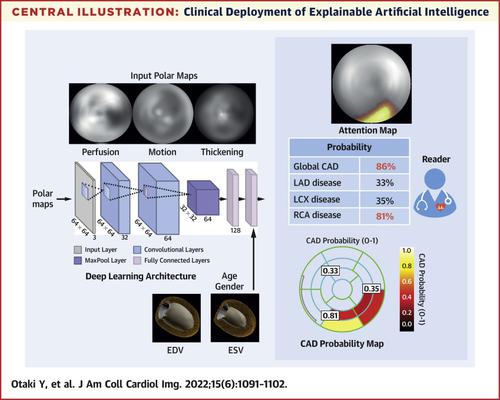JACC: Cardiovascular Imaging ( IF 12.8 ) Pub Date : 2021-07-14 , DOI: 10.1016/j.jcmg.2021.04.030 Yuka Otaki 1 , Ananya Singh 1 , Paul Kavanagh 1 , Robert J H Miller 2 , Tejas Parekh 1 , Balaji K Tamarappoo 1 , Tali Sharir 3 , Andrew J Einstein 4 , Mathews B Fish 5 , Terrence D Ruddy 6 , Philipp A Kaufmann 7 , Albert J Sinusas 8 , Edward J Miller 8 , Timothy M Bateman 9 , Sharmila Dorbala 10 , Marcelo Di Carli 10 , Sebastien Cadet 1 , Joanna X Liang 1 , Damini Dey 1 , Daniel S Berman 1 , Piotr J Slomka 1

|
Background
Explainable artificial intelligence (AI) can be integrated within standard clinical software to facilitate the acceptance of the diagnostic findings during clinical interpretation.
Objectives
This study sought to develop and evaluate a novel, general purpose, explainable deep learning model (coronary artery disease–deep learning [CAD-DL]) for the detection of obstructive CAD following single-photon emission computed tomography (SPECT) myocardial perfusion imaging (MPI).
Methods
A total of 3,578 patients with suspected CAD undergoing SPECT MPI and invasive coronary angiography within a 6-month interval from 9 centers were studied. CAD-DL computes the probability of obstructive CAD from stress myocardial perfusion, wall motion, and wall thickening maps, as well as left ventricular volumes, age, and sex. Myocardial regions contributing to the CAD-DL prediction are highlighted to explain the findings to the physician. A clinical prototype was integrated using a standard clinical workstation. Diagnostic performance by CAD-DL was compared to automated quantitative total perfusion deficit (TPD) and reader diagnosis.
Results
In total, 2,247 patients (63%) had obstructive CAD. In 10-fold repeated testing, the area under the receiver-operating characteristic curve (AUC) (95% CI) was higher according to CAD-DL (AUC: 0.83 [95% CI: 0.82-0.85]) than stress TPD (AUC: 0.78 [95% CI: 0.77-0.80]) or reader diagnosis (AUC: 0.71 [95% CI: 0.69-0.72]; P < 0.0001 for both). In external testing, the AUC in 555 patients was higher according to CAD-DL (AUC: 0.80 [95% CI: 0.76-0.84]) than stress TPD (AUC: 0.73 [95% CI: 0.69-0.77]) or reader diagnosis (AUC: 0.65 [95% CI: 0.61-0.69]; P < 0.001 for all). The present model can be integrated within standard clinical software and generates results rapidly (<12 seconds on a standard clinical workstation) and therefore could readily be incorporated into a typical clinical workflow.
Conclusions
The deep-learning model significantly surpasses the diagnostic accuracy of standard quantitative analysis and clinical visual reading for MPI. Explainable artificial intelligence can be integrated within standard clinical software to facilitate acceptance of artificial intelligence diagnosis of CAD following MPI.
中文翻译:

SPECT可解释人工智能在冠心病诊断中的临床应用
背景
可解释的人工智能 (AI) 可以集成到标准临床软件中,以促进在临床解释过程中接受诊断结果。
目标
本研究旨在开发和评估一种新颖的、通用的、可解释的深度学习模型(冠状动脉疾病-深度学习 [CAD-DL]),用于在单光子发射计算机断层扫描 (SPECT) 心肌灌注成像后检测阻塞性 CAD (初级产业部)。
方法
共研究了来自 9 个中心的 3,578 名疑似 CAD 患者在 6 个月的间隔内接受了 SPECT MPI 和有创冠状动脉造影。CAD-DL 根据负荷心肌灌注、室壁运动和室壁增厚图以及左心室容积、年龄和性别计算阻塞性 CAD 的概率。突出显示有助于 CAD-DL 预测的心肌区域,以向医生解释这些发现。使用标准临床工作站集成临床原型。将 CAD-DL 的诊断性能与自动定量总灌注不足 (TPD) 和读取器诊断进行了比较。
结果
总共有 2,247 名患者 (63%) 患有阻塞性 CAD。在 10 倍重复测试中,根据 CAD-DL(AUC:0.83 [95% CI:0.82-0.85]),接受者操作特征曲线 (AUC) (95% CI) 下的面积高于应激 TPD (AUC :0.78 [95% CI:0.77-0.80])或读者诊断(AUC:0.71 [95% CI:0.69-0.72];两者P < 0.0001)。在外部测试中,根据 CAD-DL(AUC:0.80 [95% CI:0.76-0.84]),555 名患者的 AUC 高于应激 TPD(AUC:0.73 [95% CI:0.69-0.77])或读者诊断(AUC:0.65 [95% CI:0.61-0.69];所有P < 0.001)。目前的模型可以集成到标准临床软件中并快速生成结果(在标准临床工作站上不到 12 秒),因此可以很容易地集成到典型的临床工作流程中。
结论
深度学习模型显着超过了 MPI 的标准定量分析和临床视觉阅读的诊断准确性。可解释的人工智能可以集成到标准临床软件中,以促进接受 MPI 后 CAD 的人工智能诊断。











































 京公网安备 11010802027423号
京公网安备 11010802027423号